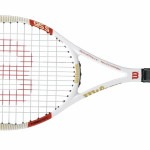Educating yourself about racquet stringing patterns
Tennis racquets have several different specifications to consider like length, overall weight, stiffness and head size just to name a few. However, one of the most important things to consider when buying a tennis racquet is the stringing pattern. Players are very predictable because they’ll spend an inordinate amount of time trying to figure out what string to select for their racquet and they’ll get hung up on whether or not it provides additional spin or how durable it is, things like that. The issue here is that before ever considering the type of string to use, there are a number of other things to consider before you ever get to that point. I’m talking about the racquet itself and in particular, the stringing pattern.
Before I continue, let’s dispel one of the more popular myths and that’s the belief that strings produce spin. A textured string may enhance spin by a small percentage but they will not produce spin on their own. Spin, in and of itself, is created by the way you swing the racquet. If you have a flat stroke, think straight back and straight forward, you’re not going to create spin. If you want topspin you should develop a good low-to-high stroke and if you want slice or backspin, you need a good high-to-low motion. So, I repeat. Spin is produced by the way you swing the racquet. If you really want to increase spin on your shots, I would advise that some tennis lessons are in order.
PARENTS TAKE NOTE
If you’re the parent of an aspiring junior this information can save you a lot of headaches, not to mention some serious cash. Juniors often play much more per week than the average adult and that means a lot of wear and tear on the strings. The old adage of how often to restring was to string as many times a year equal to the number of times you play each week. If you play twice a week then you restring every 6 months, seems easy enough right? But everyone’s game is different and if you play twice a week how does that equate to actual playing time? Do you play for 1.5 hours each time or 2? Is it doubles or is it singles? What kind of strings are you currently using and how are they holding up? All of these factors and more need to be considered.
It’s not unusual for the parents to be looking for the holy grail of strings. Cheap, one that gives great control, power and lasts forever. I hate to break it to you but that string doesn’t exist. That’s why it’s important for you work with a highly qualified racquet technician who can assess your junior’s game and make recommendations for string, correct tension, and in some cases, they might even suggest a racquet change. As your junior player grows and the level of their game changes, so too, will the string and tension and again, perhaps the racquet. Depending on the age when your kid starts to play there may be more than one racquet change along the way.
STRING PATTERNS
So just what, exactly, do I mean by string pattern? It’s the number of main (vertical) strings and the number of cross (horizontal) strings in a racquet. It’s one of the most basic differences between two racquets. This one specification of a tennis racquet can have a significant impact on how the racquet actually feels when striking a ball but more importantly, the effect it has on the shot the racquet produces. There are two very common patterns used in today’s racquets but they are not the only ones you may encounter. The first is a 16×19 stringing pattern and the second is an 18×20. When you see this in print or often stenciled on the racquet the first number refers to the number of main strings and the second refers to the number of cross strings. These patterns are a direct result of how the frame is “drilled” during its production. The lion’s share of racquets have holes drilled into them that dictate the stringing pattern and along with that, grommet strips and a bumper guard will be produced to fit that specific racquets drilling pattern. The bumper guard’s primary purpose is to protect the head of the racquet from wear and tear and a majority of racquets have the grommets built right into the bumper guard. This bumper grommet set provides a protective entry point for each string installed in the racquet.
PAY CLOSE ATTENTION TO THIS ONE

In recent years we’ve also seen different manufacturers offering “spin” racquets which typically reduce the number of cross strings. An example of this would be a racquet with a 16 x 15 stringing pattern. These racquets actually do produce more spin if the player’s swinging motion is either low-to-high (topspin) or high-to-low (slice or backspin). The dynamics are quite simple. By reducing the number of cross strings, the pattern “opens up” so to speak. Those square holes formed by the strings get much larger and therefore, allow the ball to embed itself further into the strings. This means the ball stays on the racquet much longer and as the player moves the racquet through the ball they’re able to impart a great deal of spin on the ball. The open pattern “bites” into the ball, holds it longer and the strings move and snap back, imparting some serious spin on the ball. Check out this video HERE from Wilson for a visual presentation of their Spin technology. Racquet head speed plays a key role here too and will dictate the amount of spin a player can create. Click on the photo at right to enlarge it and you can clearly see what I’m talking about. That’s a Wilson Pro Staff 95S with a 16 x 15 stringing pattern. Notice how large the holes are in that racquet and you begin to realize why the stringing pattern of a racquet is an important factor to consider when choosing a racquet.
Why is this important? First and foremost, you need to be aware that the snapback I mentioned above means that the strings are moving and as they move, they create friction. That friction will produce tiny notches in the string and before you know it, the string breaks. So are spin racquets a good or bad thing? In reality this is a personal preference because there are pros and cons to everything. If you don’t mind restringing more frequently then a spin racquet just might be the ticket for you if your goal is to increase spin on your shots. On the other hand, if you’re looking to keep your stringing costs at a minimum you should consider something other than a racquet that’s specifically designed to enhance spin. As a reminder, don’t forget my comments in the beginning of this post. Don’t be fooled into thinking that strings produce spin. Enhance spin? Sure, to a very moderate degree. Produce spin on their own? That’s a resounding NO!
In closing, don’t get spun around in circles trying to figure out what racquet is best for you. Seek out a qualified racquet technician and ask them to guide you through the process. You’ll be glad you did.


Comment (1)
Great advice regarding junior players Tim! It’s our job as technicians to educate parents about the importance of upgrading their child’s racquet and string setup, as they grow, increase strength, and develop their skills.
Junior tournament players usually outgrow their racquets in 18-24 months. During that period, sometimes changing the string setup is needed to optimize performance and durability. Also, customizing the frame’s weight and grip size can help to transition the player to the next racquet upgrade.
On a side note . . . with string and tension being the same, a denser string pattern (18×20) will produce a lower launch angle of the ball coming off the strings as compared to an open (16×19) string pattern. Something to consider during the demoing process.